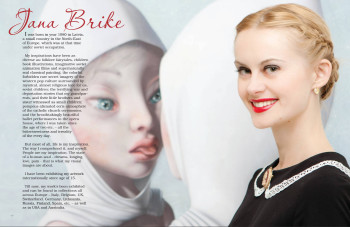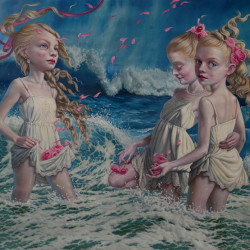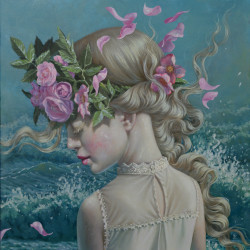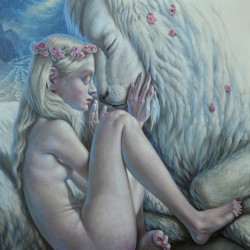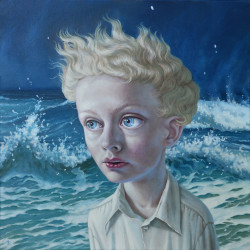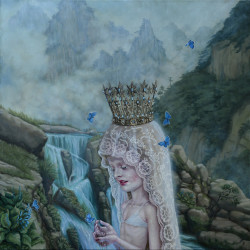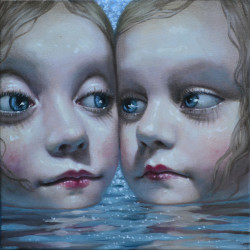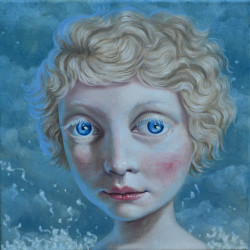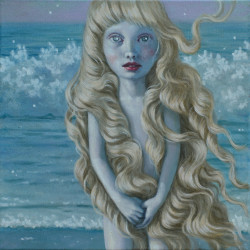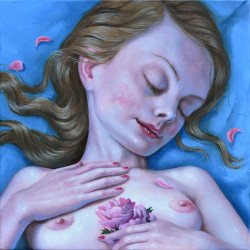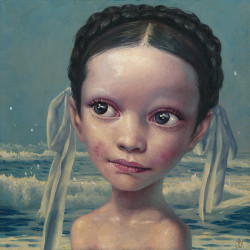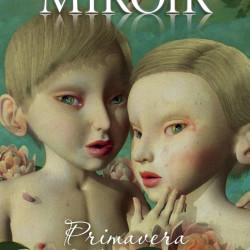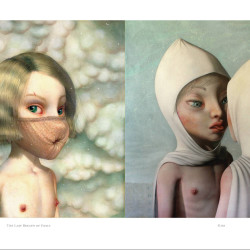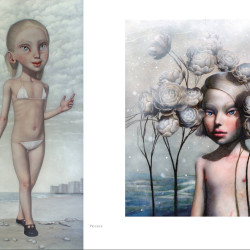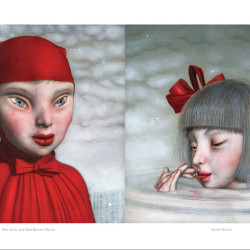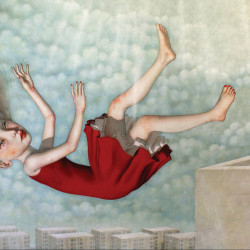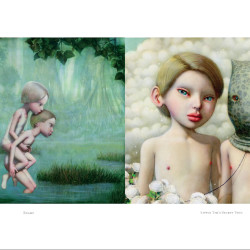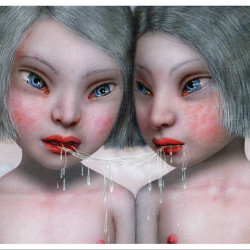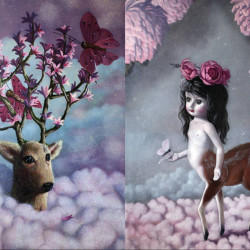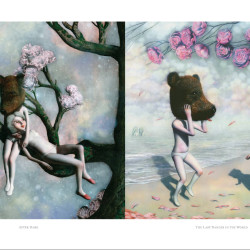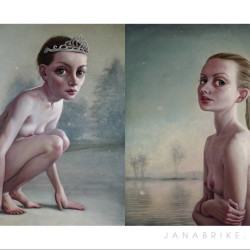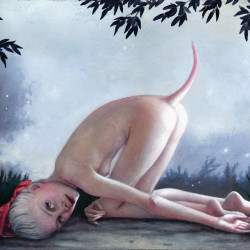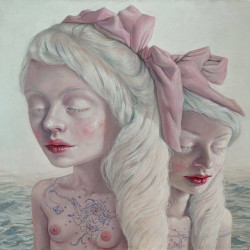Q: How long have you been painting, and what made you choose the water theme?
A: Water has been present in my paintings for many years, but never as an active element of the story. It became a foreground theme with a painting of a little sea goddess “Aphrodite with a Kitten” for “My Parallel Lives” series in 2013. The choice was quite intuitive.
The theme of that body of work for me was my feeling of what we are, how we strive to be holistic, but there always seems to be these contradicting parts and elements of our psyche that seem to live these parallel lives within us. That part of my creative process was inspired by GK Jung’s writings, and Women Who Run With the Wolves by Clarissa Pinkola Estés.
The Aphrodite painting was integral part of this body of work for me in some deep mythical way. And I felt so connected to the theme that I expanded on it in a whole new set of paintings. I will continue the subject in my new paintings as well.
I love how vast amounts of water like an ocean seem to harbor mystery, secret, and sense of danger. It makes a very appropriate space for my fragile inwardly immersed beings.
Q: Have you been formally trained, and if so from what institution? Or are you self taught?
A: I have a master’s degree in painting from the Art Academy of Latvia.
Q: What are your feelings about the conservation of the oceans, and fresh water lakes and streams?
A: My feelings are not exclusively about the water! These past few years I’ve travelled the world, and it has changed my perspectives and understandings considerably. Especially countries where people are poor, but that are highly over-populated like parts of China, or sometimes naturally dry like parts of India. What I’ve seen is beyond anything words could describe!
I just know we must change our mindset about what is a true value, and fast. To realize that economic gain for one corporation or even one country or another is not a reason enough to destroy the fragile ecosystem that feeds us. What I say may seem triviality that’s been heard too many times to pay attention. But the biggest responsibility undeniably is on the conscience of the more educated and prosperous people and countries that—wanting to own and consume more—are leaving devastation to our children. And the worst devastation of all is left somewhere away where our eyes cannot see daily, in places we would describe in foul-words like “third world.” There is no such first, second or third world—there is just one for all of us! Everything is connected!
Q: Was your family supportive of your artistic endeavors?
A: I started a very professional education in traditional arts when I was very young, just 10 or so years old. It was during the last gasps of the Soviet occupation in my country. At that time my family was supportive. Being an artist in the Soviet Union was almost like having a good regular job – a painter would receive a monthly salary through the Artists Union, but had to create a certain amount of specific artworks for the state. After the collapse, when the country became free, my family saw my future profession choice as a plain survival problem throughout my lifetime. But because of my love and commitment to my work, and support from so many people who have cared for what I do, I’m surviving fine.
Q: Is there someone special who has encouraged your work and your path as an artist?
A: I have met many special people who have been rays of sunshine on my path—some constant, and some at some crucial turning points of my life. I won’t name individuals, but I am eternally grateful to a lot— artist friends who inspire by example, collectors who would buy my art and introduce me to a gallery, gallery owners who would believe in me and let me work without trying to break me, publishers who would follow my new work and write about it. It helps to know that my work I love to do so much meets a strong support and resonance in many people. So even when I happen to meet criticism and negativity, assessing the total balance it just makes me smile.
I have actually never searched for a gallery, or put much effort into getting my name out—it has all been an organic flow full of love.
Q: What are your hopes and dreams or future goals?
A: It’s a secret! [smiles]
Mostly because I do set quite strong goals to keep my flow focused and more determined, but they are never set in stone. They are a necessary compass needle but not the final destination. My experience shows that when life carries you right past without ever touching what you imagined to be your strongest goal, there is always a very very big possibility that you are going to some place much better, and originally yours. I would have never set the life I am living now as my future goal when I was young, as I would have never believed it possible!
In general, I am more a dreams than goals kind of person. Goals you make with your mind, but the mind can put together just something it has seen before; it will never be your own original life, but something borrowed and distorted by your crooked beliefs. But dreams are the heart’s strongest desire. They cannot be wrong.
A true miracle is possible when you blend your heart and mind in one, without inner contradiction, though.
Q: Tell us if there is any special significance about water for you.
A: There is.
First, it’s the environment of my country. The Baltic Sea coastline is magic. There are also a lot of rivers, lakes, underground water—water is everywhere, and there is a great beauty in the natural landscape of not just water bodies, but also rain, snow, ice, mist, frost and other water forms here. We often don’t realize and appreciate what a great value and wealth that is! A homeland that can sustain and feed you.
There is also an intimate significance. I’ve been haunted by water dreams my whole life – tidal waves and tsunamis in particular—so much so that I took the effort to investigate. Water element is almost everywhere associated with strong emotion and feelings and passion. Something you can be overwhelmed with if you have the mental concept of needing to control it, which is often my issue indeed! Water is also the element of the feminine aspect, which is a strongly present backbone of my whole art process.
I am also strongly attracted to the science about the water element—about the molecular structure of water and how it can contain information. I find it deeply captivating!
Q: Can you tell us a little about your creative process?
A: I work full working days—sketch, take photos, write and paint. I used to do also a lot of other types of work, like animation, installation, sculpture. It helps me keep the painting process more fresh and inspired. I wish to have more time for such diversity.
My painting process actually varies significantly from piece to piece. Some works I pre-plan long and slow, make many sketches, and then change a lot in the process. Some come instantaneously and easy straight on canvas. The biggest are most often not the ones I have spent most of my time working on.
Q: Do you have any advice for painter who would like to paint water themes?
A: Keep in mind your own individual “water feeling” you want to capture. And then just practice and practice, and practice. There’s no other advice for a painter. I really have no special tricks in my painting process. I myself get quite lost in trying to capture the translucence, color, reflectivity, mass, structure and fluidity of a water body. Sometimes I find it close to impossible. I always use a ton of reference photos though, never just one.
And the main thing — just love what you do!



